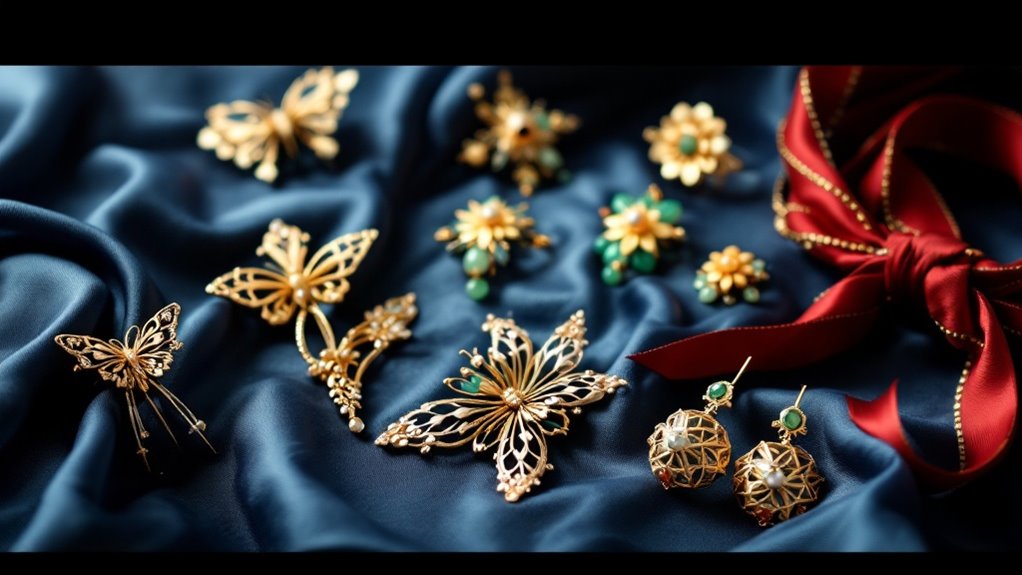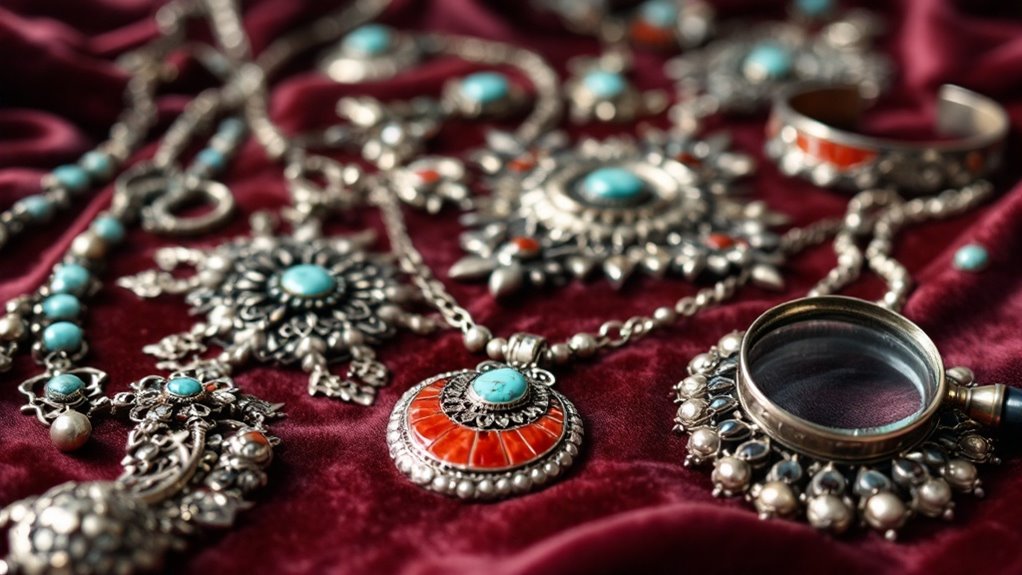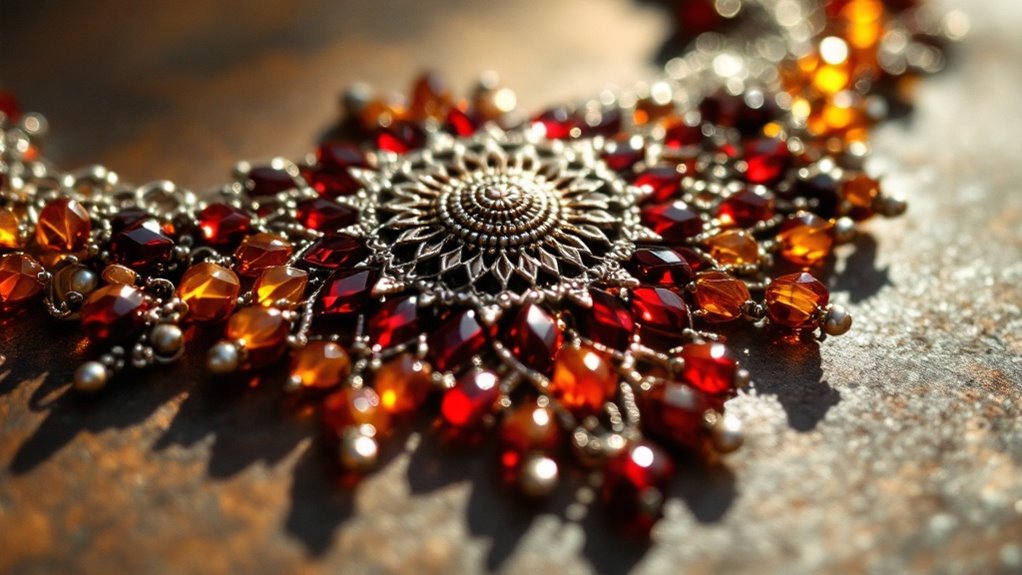Traditional Korean jewelry tells a story that's been crafted over thousands of years through precious metals and stones. You'll discover pieces that combine artistic beauty with deep cultural significance, from royal crowns to everyday accessories. Whether you're a serious collector or simply appreciate fine craftsmanship, understanding the basics of Korean jewelry can help you make smart purchases. The journey into this ancient art form reveals secrets that modern buyers need to know.
Historical Origins of Korean Jewelry Making

Korean jewelry making traces its roots back over 5,000 years to the Bronze Age, when early craftsmen first began working with precious metals and stones.
You'll find that the ancient kingdoms of Goguryeo, Baekje, and Silla played pivotal roles in developing distinctive metalworking techniques and designs. The Three Kingdoms period (57 BC-935 AD) saw jewelry become a symbol of social status and power.
As Buddhism spread throughout Korea, you'll notice its influence in jewelry motifs featuring lotus flowers and celestial beings.
The Goryeo Dynasty (918-1392) brought sophisticated gold filigree work and inlaid jade pieces, while the Joseon Dynasty (1392-1910) emphasized simpler designs reflecting Confucian values.
Notable techniques like nanip (wire inlay) and yugum (twisted wire) remain significant in modern Korean jewelry making.
Essential Materials and Gemstones

Throughout history, precious metals have formed the foundation of traditional Korean jewelry making. Gold and silver remain the most cherished materials, with gold symbolizing royalty and silver representing purity. You'll find these metals crafted into intricate designs, often combined with jade, amber, and various gemstones.
| Material | Traditional Significance |
|---|---|
| Gold | Royal power, prosperity |
| Silver | Purity, protection |
| Jade | Virtue, longevity |
Korean artisans have long favored specific gemstones for their cultural meaning and natural beauty. Jade, particularly in its deep green variety, is considered the most precious stone in Korean jewelry. You'll also encounter coral, which represents wealth and status, and amber, believed to bring good fortune. Today's craftsmen continue using these traditional materials while incorporating modern techniques to create stunning pieces.
Types of Traditional Korean Jewelry Pieces

While each region developed its own distinct style, traditional Korean jewelry pieces generally fall into several main categories that have endured for centuries.
You'll find these pieces worn during special occasions, ceremonies, and as symbols of social status.
- Dwikkoji (떨잠) – Ornate hairpins featuring jade, pearl, or coral decorations, often adorned with butterfly or flower motifs
- Norigae (노리개) – Decorative hanging ornaments attached to hanbok sashes, consisting of intricate knots and precious stones
- Binyeo (비녀) – Long hairpins made from gold, silver, or jade, used to secure traditional hairstyles
- Gujeolpan (귀걸이) – Earrings crafted from precious metals and gems, typically featuring circular or teardrop designs
These pieces showcase Korea's metalworking expertise and reflect the wearer's social position and marital status.
Cultural Symbolism and Meaning

Traditional jewelry pieces carry deep spiritual and cultural meanings that extend far beyond mere decoration.
In Korean culture, you'll find dragons symbolizing power and good fortune, while phoenixes represent nobility and virtue. The lotus flower, a recurring motif, stands for purity and enlightenment.
Colors also hold significance in Korean jewelry design. You'll notice jade's prominence, as it represents integrity and wisdom, while gold signifies wealth and prosperity.
When you're examining traditional pieces, look for the number patterns – three tiers often represent heaven, earth, and humanity, while five elements appear in designs symbolizing metal, water, wood, fire, and earth.
The placement of gems and patterns isn't random – each arrangement tells a story about status, wishes, or protection from evil spirits.
Authenticating Antique Korean Jewelry

Authenticity presents a critical challenge when evaluating antique Korean jewelry.
You'll need to examine specific hallmarks, materials, and craftsmanship techniques that indicate genuine pieces from Korea's rich jewelry-making tradition.
To verify authenticity, focus on these key indicators:
- Check for traditional metalworking techniques like chilbo (cloisonné enamel) and geumback (gold overlay), which should show slight irregularities consistent with handcrafting.
- Examine the patina and wear patterns – authentic pieces display natural aging that can't be easily replicated.
- Look for period-appropriate materials such as silver, gold, jade, or coral that match historical Korean preferences.
- Verify maker's marks or workshop stamps, particularly those from known jewelry districts like Jongno in Seoul.
Always consult experts or reputable dealers when making significant antique purchases.
Modern Korean Jewelry Interpretations
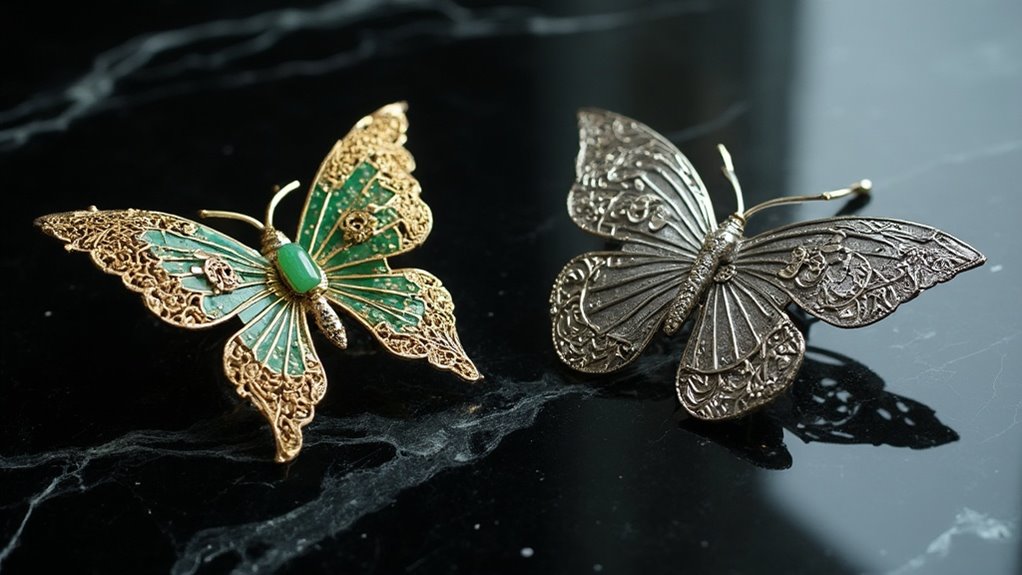
Contemporary Korean jewelry designers have masterfully blended ancestral techniques with modern aesthetics to create pieces that honor their cultural heritage.
You'll find traditional motifs like lotus flowers and phoenixes reimagined in sleek, minimalist designs using titanium and platinum alongside classic gold and silver.
Many designers now incorporate traditional metalworking methods like chilbo (Korean enameling) and geumbu (gold inlay) into avant-garde pieces that appeal to international markets.
You can discover collections featuring modernized versions of the golden butterfly pins (norigae) and statement rings inspired by royal crowns.
When shopping for modern Korean jewelry, look for pieces that showcase innovative materials while maintaining authentic cultural elements.
Leading brands like Lee Suk Woo and Woochul Kim offer excellent examples of this harmonious fusion.
Caring for Your Korean Jewelry Collection

To preserve the beauty and longevity of your Korean jewelry pieces, you'll need to follow specific care guidelines based on their materials and craftsmanship.
Traditional materials like silver, jade, and coral require gentle handling and proper storage to maintain their luster and prevent damage.
- Store your pieces individually in soft cloth pouches or lined boxes to prevent scratching and tarnishing.
- Clean silver jewelry with a specialized polishing cloth, avoiding harsh chemicals that can damage traditional patinas.
- Keep jade pieces away from direct sunlight and extreme temperatures to prevent color fading.
- Apply perfume and cosmetics before wearing your jewelry, as chemicals can react with metals and stones.
When not wearing your pieces, maintain consistent room temperature and moderate humidity levels in your storage area.
Where to Buy Traditional Korean Jewelry

Finding authentic Korean jewelry requires knowing where to look, whether you're shopping in Korea or internationally.
In Seoul, visit Insadong's traditional craft shops and the Dongdaemun Design Plaza for both modern and classic pieces. The Gyeongbokgung Palace gift shop also offers high-quality replicas of royal jewelry.
For international buyers, reputable online marketplaces like Gmarket Global and websites of established Korean jewelers offer shipping worldwide. You'll find authentic pieces through Korean cultural centers in major cities and specialized Asian craft stores.
Consider attending Korean cultural festivals, where artisans often showcase their handmade jewelry.
Be wary of mass-produced imitations on general e-commerce sites. Instead, look for pieces with certificates of authenticity or shop from verified Korean craftspeople who maintain traditional metalworking techniques.
Investment Value and Market Trends
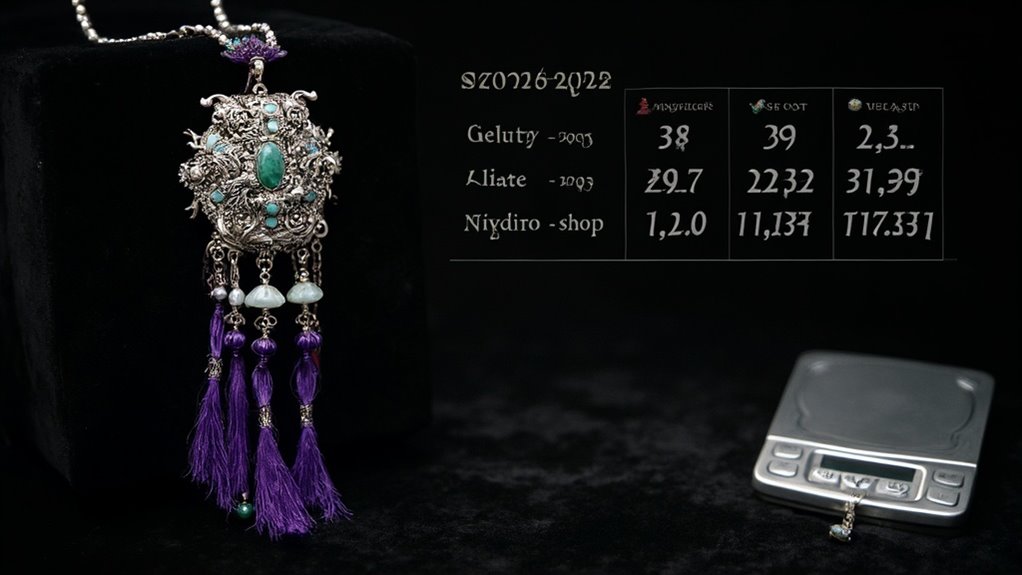
While mass-produced jewelry often depreciates after purchase, traditional Korean pieces have shown steady value appreciation over the past decade.
You'll find the highest returns on authenticated antique pieces, especially those with documented royal or noble provenance.
The market for traditional Korean jewelry continues to grow, driven by both domestic collectors and international buyers.
You can maximize your investment potential by focusing on these key factors:
- Authenticity certification from reputable Korean institutions
- Pieces made with traditional techniques like chilbo (cloisonné enamel)
- Items featuring natural jade, coral, or amber
- Jewelry with documented historical significance
When you're investing, consider working with established dealers who can provide detailed provenance documentation and market analysis to help you make informed decisions.
Conclusion
By coincidence, you'll find that the same traditional Korean jewelry-making techniques your grandmother cherished are experiencing a modern renaissance. As you browse today's market, you're perfectly positioned to acquire pieces that'll not only appreciate in value but also carry cultural significance. Whether you're drawn to antique chilbo or contemporary interpretations, you've chosen an ideal time to invest in these timeless treasures.

